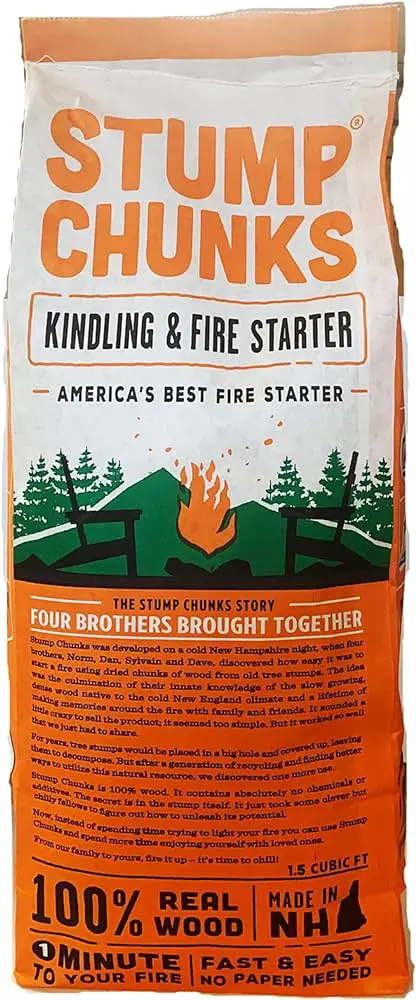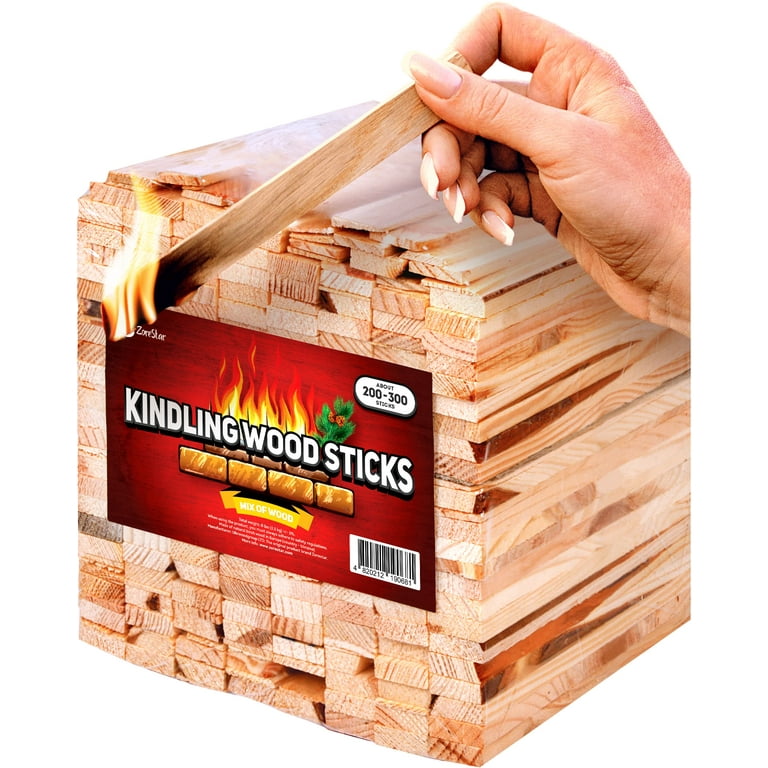Kindling wood is small pieces used for fire starting, often made from softwoods like pine or cedar. It ignites easily and helps light larger firewood pieces for a sustained fire.
Kindling wood plays a crucial role in starting and maintaining fires, ensuring efficient burning and heat production. Natural materials like pine cones, newspaper knots, or bark can also serve as alternative kindling sources. The purpose of kindling is to gradually heat the fire, helping it catch and burn effectively.
Dry kindling is essential for successful fire ignition, while wet or damp kindling may hinder the process. Understanding the importance and types of kindling wood is key to building a successful fire.


Credit: www.walmart.com
Understanding Kindling Wood
Kindling wood is small, easily combustible materials used to ignite a fire. It consists of dry, lightweight pieces of wood that catch fire quickly.
The Role Of Kindling In Fire Starting
Kindling plays a crucial role in the initial stages of starting a fire. It provides the necessary heat to ignite larger pieces of firewood.
Effective kindling should be dry, well-aerated, and easily ignitable. It helps establish a strong fire base for sustained burning.
What wood is used for kindling?
Softwood kindling, such as pine, cedar, spruce, and fir, is popular due to its high resin content, making it highly flammable. Hardwoods like birch, maple, and oak also serve as kindling, offering longer burn times and sustained heat.
What can be used as kindling?
- Small dry split wood pieces
- Pine cones
- Newspaper tied in a knot
- Bark
What is the purpose of kindling?
Kindling gradually heats the fire, allowing it to burn long enough to ignite the main fuel source. It is essential for ensuring a successful fire, requiring dry kindling for effective ignition.

Credit: www.amazon.com
Types Of Kindling Wood
Softwood Kindling
Softwood kindling, such as pine, cedar, spruce, and fir, is popular due to its high resin content, making it highly flammable.
Hardwood Kindling
Hardwoods like birch, maple, and oak are also used as kindling, offering a longer burn time and more sustained heat.
Kindling wood plays a vital role in starting a fire by providing the initial flames needed to ignite larger firewood pieces. It is typically smaller, thinner pieces of wood that are easily combustible. There are two main types of kindling wood: softwood and hardwood.
Using Alternative Kindling
Creative Kindling Options
When it comes to starting a fire, the use of kindling is essential, but traditional kindling may not always be readily available. In such cases, it’s helpful to know about creative kindling options that can effectively ignite a fire without the need for conventional materials. Utilizing alternative kindling not only offers a sustainable approach but also allows for flexibility in various situations.
Substitutes For Kindling
When traditional kindling is scarce, there are several substitutes that can serve the same purpose. Substitutes can include items such as pine cones, newspaper tied in knots, dry bark, or even certain types of dry, split wood. These alternatives can effectively play the role of conventional kindling, providing a suitable source of ignition for your fire.
Importance Of Kindling
Kindling wood is essential for starting a fire, as it ignites quickly and helps to light the larger firewood effectively. It is typically made from softwoods such as pine or cedar, which have high resin content, making them highly flammable.
Using kindling wood is crucial for creating a sustainable and long-lasting fire.
Kindling For Effective Fire Ignition
When it comes to building a fire, kindling plays a crucial role in achieving effective fire ignition. Kindling refers to small, dry pieces of wood that are used to start a fire. Its purpose is to create a quick and intense flame that can ignite larger pieces of firewood.
Using kindling is essential because it provides a reliable and efficient way to start a fire. Without it, igniting larger logs can be a challenging task, particularly if the firewood is damp or wet. By using kindling, you can ensure a steady source of ignition that will help your fire catch and burn gradually.
The Critical Role Of Dry Kindling
Dry kindling is of utmost importance when it comes to fire ignition. Wet or damp kindling will struggle to ignite, resulting in a frustrating and inefficient fire-starting process.
Using dry kindling, on the other hand, will significantly increase your chances of successfully starting a fire. Dry kindling burns quickly and easily, creating a strong flame that can ignite the larger pieces of firewood. It acts as a catalyst that allows the fire to spread and establish itself.
To ensure you have dry kindling available, it’s recommended to store it in a dry and well-ventilated area. This way, you can always rely on it to start your fire quickly and efficiently.
Kindling can be made from various types of wood, including softwoods such as pine, cedar, spruce, and fir. These softwoods are popular choices due to their high resin content, which makes them highly flammable. Additionally, hardwoods like birch, maple, and oak can also serve as kindling, providing a longer burn time and generating more sustained heat.
Remember, having dry and properly prepared kindling is crucial for a successful fire ignition. So, make sure you have a good supply of dry kindling readily available before you start your fire-building process.
Tips For Using Kindling
Kindling wood, such as pine or birch, is essential for starting a fire due to its high flammability. To use kindling effectively, start with small, dry pieces and gradually add larger ones for a sustained burn and increased heat output.
Other options like pine cones or bark can also be used as kindling alternatives.
Best Practices For Kindling
When it comes to using kindling wood, there are some best practices that can help you start a fire efficiently and effectively. Follow these tips to maximize the effectiveness of your kindling and ensure a successful fire-starting experience: 1. Use dry kindling: Wet or damp kindling will struggle to ignite and may prevent your fire from starting. Ensure your kindling is completely dry before using it. 2. Cut kindling into small pieces: Kindling should be cut into small, manageable pieces to facilitate quick and easy ignition. Cutting kindling into thin sticks or small chunks will help it catch fire faster. 3. Arrange kindling properly: Properly arranging your kindling is crucial for a successful fire. Start with a base layer of larger pieces of kindling and stack smaller pieces on top in a crisscross pattern. This arrangement allows for optimal airflow and helps the fire spread evenly. 4. Use the right amount of kindling: It’s important to use enough kindling to start the fire but not so much that it smothers the flames. Finding the right balance may require some experimentation, but as a general rule, start with a small amount of kindling and gradually increase if needed.Maximizing The Efficiency Of Kindling
To get the most out of your kindling wood, consider the following tips that can help maximize its efficiency and make your fires burn hotter and longer: 1. Use resinous softwoods: Softwoods like pine, cedar, spruce, and fir contain high levels of resin, making them highly flammable. Opting for kindling made from these types of wood can help ignite your fire more quickly. 2. Consider hardwood kindling: While softwoods are commonly used for kindling, hardwoods like birch, maple, and oak can also be used. Hardwoods provide a longer burn time and generate more sustained heat, which can be beneficial in certain situations. 3. Combine kindling with other fire-starting materials: If you’re struggling to get your fire started, consider combining your kindling with additional fire-starting materials such as newspaper, pinecones, or bark. These items can help create a stronger initial flame and make it easier for the kindling to catch fire. 4. Store kindling properly: To ensure your kindling remains dry and ready for use, store it in a dry and well-ventilated area. Avoid exposing it to moisture or damp conditions that can hinder its effectiveness. By following these best practices and maximizing the efficiency of your kindling, you’ll be well on your way to starting a successful fire every time. Remember to always prioritize safety and exercise caution when handling fire and flammable materials. Happy fire-starting!
Credit: www.walmart.com
Frequently Asked Questions Of What Is Kindling Wood
What Wood Is Used For Kindling?
Kindling wood for fires is typically softwood such as pine, cedar, spruce, and fir due to their high resin content. Hardwoods like birch, maple, and oak can also be used for longer burn time and sustained heat.
What Is The Difference Between Kindling Wood And Firewood?
Kindling wood is small pieces for starting fires, often made from softwoods for quick burning. Firewood, on the other hand, are larger logs for keeping the fire going.
What Can Be Used As Kindling?
Kindling is small pieces of dry split wood that are used to start a fire. It can also be made from pine cones, newspaper, or bark. Softwoods like pine, cedar, spruce, and fir are popular choices for kindling due to their high resin content.
Hardwoods like birch, maple, and oak can also be used, providing a longer burn time and more sustained heat.
What Is The Purpose Of Kindling?
Kindling wood is small pieces of wood used to start a fire. It gradually heats the fire and allows it to burn long enough to light the fuel source. Dry kindling is essential for a successful fire, as wet or damp kindling won’t ignite properly.
What Is Kindling Wood And How Is It Different From Firewood?
Kindling wood is thinner than firewood and burns quicker, making it easier to catch fire effectively.
Conclusion
Kindling wood plays a crucial role in initiating a fire and sustaining it effectively. Whether made from softwoods like pine or hardwoods such as birch, its thin and highly flammable nature makes it essential for starting a fire. With the right kindling, one can ensure a consistent and efficient burn, making it an integral component of a successful fireside experience.